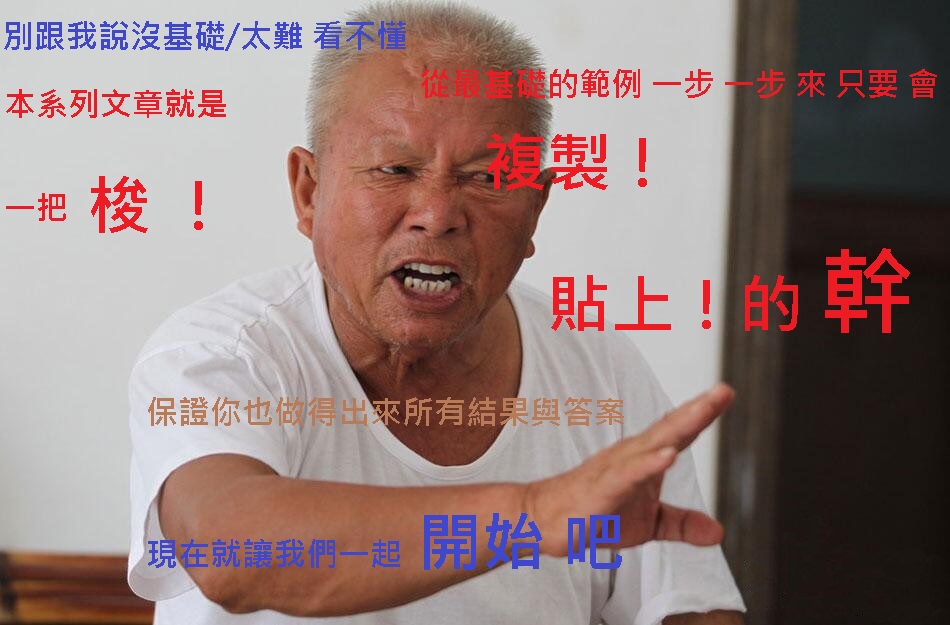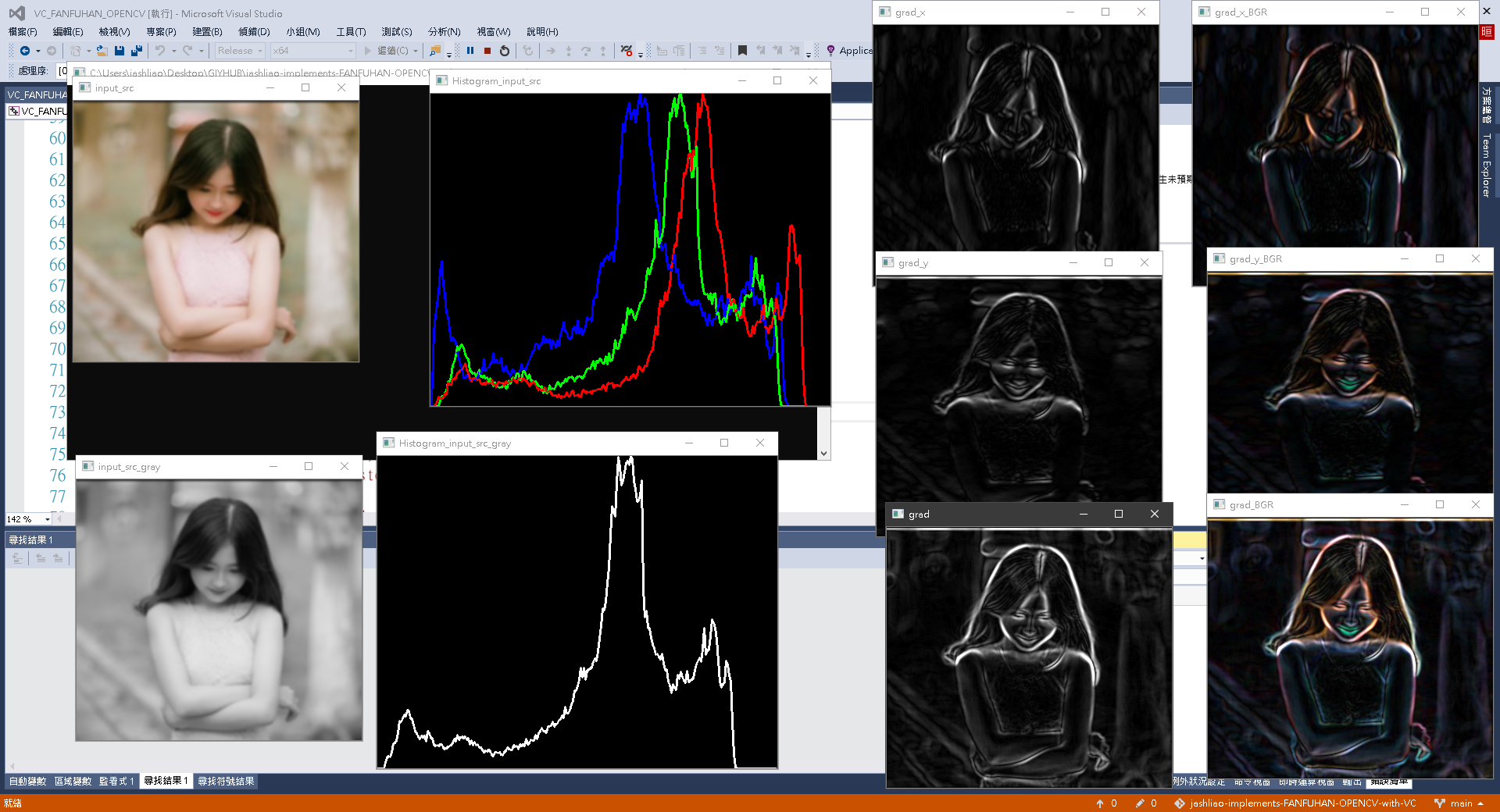jashliao 用 VC++ 實現 fanfuhan OpenCV 教學031 ~ opencv-031-圖像梯度之Sobel(邊緣檢測) [彩色/灰階 圖像 Sobel運算]
jashliao 用 VC++ 實現 fanfuhan OpenCV 教學031 ~ opencv-031-圖像梯度之Sobel(邊緣檢測) [彩色/灰階 圖像 Sobel運算]
資料來源: https://fanfuhan.github.io/
https://fanfuhan.github.io/2019/04/09/opencv-031/
GITHUB:https://github.com/jash-git/fanfuhan_ML_OpenCV
https://github.com/jash-git/jashliao-implements-FANFUHAN-OPENCV-with-VC
★前言:

★主題:
Sobel算子主要用於邊緣檢測;
邊緣:是像素值發生躍遷的地方,是圖像的顯著特徵之一,在圖像特徵提取, 對象檢測, 模式識別等方面都有重要的作用;
如何提取邊緣,對圖像求它的一階導數;delta = f(x) – f(x-1), delta越大,說明在x方向變化越大;
sobel算子是離散微分算子,用來計算圖像灰度的近似梯度,sobel算子功能集合高斯平滑和微分求導;又被稱為一階微分算子,求導算子,在水平和垂直兩個方向上求導,得到圖像x方向與y方向梯度圖像
使用Sobel算子提取圖像邊緣(邊緣檢測),包含以下四個步驟(SOP):
01.對圖像進行高斯模糊;
02.將圖像轉換到灰度空間;
03.利用Sobel算子或者Scharr算子計算圖像梯度;
04.利用提取的梯度,調整圖像灰度值,提取圖像邊緣;
OPENCV提供Sobel算子函數條列如下:
void Sobel( InputArray src, OutputArray dst, int ddepth,
int dx, int dy, int ksize = 3,
double scale = 1, double delta = 0,
int borderType = BORDER_DEFAULT );
src表示輸入的圖像
dst表示輸出的梯度;
ddepth表示輸出梯度的數據類型,必須大於輸入的圖像數據類型
dx=1, dy=0表示對x方向計算梯度;
dx=0, dy=1表示對y方向計算梯度;
★C++
// VC_FANFUHAN_OPENCV031.cpp : 定義主控台應用程式的進入點。
//
/*
// Debug | x32
通用屬性
| C/C++
| | 一般
| | 其他 Include 目錄 -> C:\opencv\build\include
|
| 連結器
| |一一般
| | 其他程式庫目錄 -> C:\opencv\build\x64\vc15\lib
|
| |一輸入
| | 其他相依性 -> opencv_world411d.lib;%(AdditionalDependencies)
// Releas | x64
組態屬性
| C/C++
| | 一般
| | 其他 Include 目錄 -> C:\opencv\build\include
|
| 連結器
| |一般
| | 其他程式庫目錄 -> C:\opencv\build\x64\vc15\lib
|
| |一輸入
| | 其他相依性 -> opencv_world411.lib;%(AdditionalDependencies)
*/
#include "stdafx.h"
#include <iostream>
#include <opencv2/opencv.hpp>
#include <opencv2/core/core.hpp>
#include <opencv2/highgui/highgui.hpp>
using namespace std;
using namespace cv;
void blur_demo(Mat &image, Mat &sum);
void edge_demo(Mat &image, Mat &sum);
int getblockSum(Mat &sum, int x1, int y1, int x2, int y2, int i);
void showHistogram(InputArray src, cv::String StrTitle);
void backProjection_demo(Mat &mat, Mat &model);
void blur3x3(Mat &src, Mat *det);
void add_salt_pepper_noise(Mat &image);
void add_gaussian_noise(Mat &image);
void pause()
{
printf("Press Enter key to continue...");
fgetc(stdin);
}
int main()
{
Mat src = imread("../../images/test.png");
if (src.empty())
{
cout << "could not load image.." << endl;
pause();
return -1;
}
else
{
Mat src_gray;
cvtColor(src, src_gray, COLOR_BGR2GRAY);
GaussianBlur(src, src, Size(7, 7), 0);
GaussianBlur(src_gray, src_gray, Size(7, 7), 0);
imshow("input_src", src);
showHistogram(src, "Histogram_input_src");
imshow("input_src_gray", src_gray);
showHistogram(src_gray, "Histogram_input_src_gray");
Mat grad_x00, grad_y00, grad00;
// 求取x方向和y方向梯度
Sobel(src, grad_x00, CV_32F, 1, 0);
Sobel(src, grad_y00, CV_32F, 0, 1);
convertScaleAbs(grad_x00, grad_x00);
convertScaleAbs(grad_y00, grad_y00);
// 求取总梯度
add(grad_x00, grad_y00, grad00, Mat(), CV_16S);
convertScaleAbs(grad00, grad00);
imshow("grad_x_BGR", grad_x00);
imshow("grad_y_BGR", grad_y00);
imshow("grad_BGR", grad00);
Mat grad_x01, grad_y01, grad01;
// 求取x方向和y方向梯度
Sobel(src_gray, grad_x01, CV_16S, 1, 0);
Sobel(src_gray, grad_y01, CV_16S, 0, 1);
convertScaleAbs(grad_x01, grad_x01);
convertScaleAbs(grad_y01, grad_y01);
add(grad_x01, grad_y01, grad01, Mat(), CV_16S);
convertScaleAbs(grad01, grad01);
imshow("grad_x", grad_x01);
imshow("grad_y", grad_y01);
imshow("grad", grad01);
waitKey(0);
return 0;
}
return 0;
}
void blur_demo(Mat &image, Mat &sum) {
int w = image.cols;
int h = image.rows;
Mat result = Mat::zeros(image.size(), image.type());
int x2 = 0, y2 = 0;
int x1 = 0, y1 = 0;
int ksize = 5;
int radius = ksize / 2;
int ch = image.channels();
int cx = 0, cy = 0;
for (int row = 0; row < h + radius; row++) {
y2 = (row + 1)>h ? h : (row + 1);
y1 = (row - ksize) < 0 ? 0 : (row - ksize);
for (int col = 0; col < w + radius; col++) {
x2 = (col + 1)>w ? w : (col + 1);
x1 = (col - ksize) < 0 ? 0 : (col - ksize);
cx = (col - radius) < 0 ? 0 : col - radius;
cy = (row - radius) < 0 ? 0 : row - radius;
int num = (x2 - x1)*(y2 - y1);
for (int i = 0; i < ch; i++) {
// 积分图查找和表,计算卷积
int s = getblockSum(sum, x1, y1, x2, y2, i);
result.at<Vec3b>(cy, cx)[i] = saturate_cast<uchar>(s / num);
}
}
}
imshow("blur_demo", result);
}
/**
* 3x3 sobel 垂直边缘检测演示
*/
void edge_demo(Mat &image, Mat &sum) {
int w = image.cols;
int h = image.rows;
Mat result = Mat::zeros(image.size(), CV_32SC3);
int x2 = 0, y2 = 0;
int x1 = 0, y1 = 0;
int ksize = 3; // 算子大小,可以修改,越大边缘效应越明显
int radius = ksize / 2;
int ch = image.channels();
int cx = 0, cy = 0;
for (int row = 0; row < h + radius; row++) {
y2 = (row + 1)>h ? h : (row + 1);
y1 = (row - ksize) < 0 ? 0 : (row - ksize);
for (int col = 0; col < w + radius; col++) {
x2 = (col + 1)>w ? w : (col + 1);
x1 = (col - ksize) < 0 ? 0 : (col - ksize);
cx = (col - radius) < 0 ? 0 : col - radius;
cy = (row - radius) < 0 ? 0 : row - radius;
int num = (x2 - x1)*(y2 - y1);
for (int i = 0; i < ch; i++) {
// 积分图查找和表,计算卷积
int s1 = getblockSum(sum, x1, y1, cx, y2, i);
int s2 = getblockSum(sum, cx, y1, x2, y2, i);
result.at<Vec3i>(cy, cx)[i] = saturate_cast<int>(s2 - s1);
}
}
}
Mat dst, gray;
convertScaleAbs(result, dst);
normalize(dst, dst, 0, 255, NORM_MINMAX);
cvtColor(dst, gray, COLOR_BGR2GRAY);
imshow("edge_demo", gray);
}
int getblockSum(Mat &sum, int x1, int y1, int x2, int y2, int i) {
int tl = sum.at<Vec3i>(y1, x1)[i];
int tr = sum.at<Vec3i>(y2, x1)[i];
int bl = sum.at<Vec3i>(y1, x2)[i];
int br = sum.at<Vec3i>(y2, x2)[i];
int s = (br - bl - tr + tl);
return s;
}
void add_gaussian_noise(Mat &image) {
Mat noise = Mat::zeros(image.size(), image.type());
// 产生高斯噪声
randn(noise, (15, 15, 15), (30, 30, 30));
Mat dst;
add(image, noise, dst);
image = dst.clone();//dst.copyTo(image);//圖像複製
//imshow("gaussian_noise", dst);
}
void add_salt_pepper_noise(Mat &image) {
// 随机数产生器
RNG rng(12345);
for (int i = 0; i < 1000; ++i) {
int x = rng.uniform(0, image.rows);
int y = rng.uniform(0, image.cols);
if (i % 2 == 1) {
image.at<Vec3b>(y, x) = Vec3b(255, 255, 255);
}
else {
image.at<Vec3b>(y, x) = Vec3b(0, 0, 0);
}
}
//imshow("saltp_epper", image);
}
void blur3x3(Mat &src, Mat *det)
{
// 3x3 均值模糊,自定义版本实现
for (int row = 1; row < src.rows - 1; row++) {
for (int col = 1; col < src.cols - 1; col++) {
Vec3b p1 = src.at<Vec3b>(row - 1, col - 1);
Vec3b p2 = src.at<Vec3b>(row - 1, col);
Vec3b p3 = src.at<Vec3b>(row - 1, col + 1);
Vec3b p4 = src.at<Vec3b>(row, col - 1);
Vec3b p5 = src.at<Vec3b>(row, col);
Vec3b p6 = src.at<Vec3b>(row, col + 1);
Vec3b p7 = src.at<Vec3b>(row + 1, col - 1);
Vec3b p8 = src.at<Vec3b>(row + 1, col);
Vec3b p9 = src.at<Vec3b>(row + 1, col + 1);
int b = p1[0] + p2[0] + p3[0] + p4[0] + p5[0] + p6[0] + p7[0] + p8[0] + p9[0];
int g = p1[1] + p2[1] + p3[1] + p4[1] + p5[1] + p6[1] + p7[1] + p8[1] + p9[1];
int r = p1[2] + p2[2] + p3[2] + p4[2] + p5[2] + p6[2] + p7[2] + p8[2] + p9[2];
det->at<Vec3b>(row, col)[0] = saturate_cast<uchar>(b / 9);
det->at<Vec3b>(row, col)[1] = saturate_cast<uchar>(g / 9);
det->at<Vec3b>(row, col)[2] = saturate_cast<uchar>(r / 9);
}
}
}
void backProjection_demo(Mat &image, Mat &model)
{
Mat image_hsv, model_hsv;
cvtColor(image, image_hsv, COLOR_BGR2HSV);//彩色轉HSV
cvtColor(model, model_hsv, COLOR_BGR2HSV);
// 定义直方图参数与属性
int h_bins = 32, s_bins = 32;
int histSize[] = { h_bins, s_bins };//要切分的像素強度值範圍,預設為256。每個channel皆可指定一個範圍。例如,[32,32,32] 表示RGB三個channels皆切分為32區段
float h_ranges[] = { 0, 180 }, s_ranges[] = { 0, 256 };
const float* ranges[] = { h_ranges, s_ranges };
int channels[] = { 0, 1 };
Mat roiHist;//計算ROI的直方圖
calcHist(&model_hsv, 1, channels, Mat(), roiHist, 2, histSize, ranges);
normalize(roiHist, roiHist, 0, 255, NORM_MINMAX, -1, Mat());
Mat roiproj, backproj;
calcBackProject(&image_hsv, 1, channels, roiHist, roiproj, ranges);//使用反向投影 產生ROI(前景)的mask
bitwise_not(roiproj, backproj);//產生背景的mask
imshow("ROIProj", roiproj);
imshow("BackProj", backproj);
}
void showHistogram(InputArray src, cv::String StrTitle)
{
bool blnGray = false;
if (src.channels() == 1)
{
blnGray = true;
}
// 三通道/單通道 直方圖 紀錄陣列
vector<Mat> bgr_plane;
vector<Mat> gray_plane;
// 定义参数变量
const int channels[1] = { 0 };
const int bins[1] = { 256 };
float hranges[2] = { 0, 255 };
const float *ranges[1] = { hranges };
Mat b_hist, g_hist, r_hist, hist;
// 计算三通道直方图
/*
void calcHist( const Mat* images, int nimages,const int* channels, InputArray mask,OutputArray hist, int dims, const int* histSize,const float** ranges, bool uniform=true, bool accumulate=false );
1.輸入的圖像數組
2.輸入數組的個數
3.通道數
4.掩碼
5.直方圖
6.直方圖維度
7.直方圖每個維度的尺寸數組
8.每一維數組的範圍
9.直方圖是否是均勻
10.配置階段不清零
*/
if (blnGray)
{
split(src, gray_plane);
calcHist(&gray_plane[0], 1, 0, Mat(), hist, 1, bins, ranges);
}
else
{
split(src, bgr_plane);
calcHist(&bgr_plane[0], 1, 0, Mat(), b_hist, 1, bins, ranges);
calcHist(&bgr_plane[1], 1, 0, Mat(), g_hist, 1, bins, ranges);
calcHist(&bgr_plane[2], 1, 0, Mat(), r_hist, 1, bins, ranges);
}
/*
* 显示直方图
*/
int hist_w = 512;
int hist_h = 400;
int bin_w = cvRound((double)hist_w / bins[0]);
Mat histImage = Mat::zeros(hist_h, hist_w, CV_8UC3);
// 归一化直方图数据
if (blnGray)
{
normalize(hist, hist, 0, histImage.rows, NORM_MINMAX, -1);
}
else
{
normalize(b_hist, b_hist, 0, histImage.rows, NORM_MINMAX, -1);
normalize(g_hist, g_hist, 0, histImage.rows, NORM_MINMAX, -1);
normalize(r_hist, r_hist, 0, histImage.rows, NORM_MINMAX, -1);
}
// 绘制直方图曲线
for (int i = 1; i < bins[0]; ++i)
{
if (blnGray)
{
line(histImage, Point(bin_w * (i - 1), hist_h - cvRound(hist.at<float>(i - 1))),
Point(bin_w * (i), hist_h - cvRound(hist.at<float>(i))), Scalar(255, 255, 255),
2, 8, 0);
}
else
{
line(histImage, Point(bin_w * (i - 1), hist_h - cvRound(b_hist.at<float>(i - 1))),
Point(bin_w * (i), hist_h - cvRound(b_hist.at<float>(i))), Scalar(255, 0, 0),
2, 8, 0);
line(histImage, Point(bin_w * (i - 1), hist_h - cvRound(g_hist.at<float>(i - 1))),
Point(bin_w * (i), hist_h - cvRound(g_hist.at<float>(i))), Scalar(0, 255, 0),
2, 8, 0);
line(histImage, Point(bin_w * (i - 1), hist_h - cvRound(r_hist.at<float>(i - 1))),
Point(bin_w * (i), hist_h - cvRound(r_hist.at<float>(i))), Scalar(0, 0, 255),
2, 8, 0);
}
}
imshow(StrTitle, histImage);
}
★Python
import cv2 as cv
import numpy as np
src = cv.imread("D:/images/grad.png")
cv.namedWindow("input", cv.WINDOW_AUTOSIZE)
cv.imshow("input", src)
h, w = src.shape[:2]
x_grad = cv.Sobel(src, cv.CV_32F, 1, 0)
y_grad = cv.Sobel(src, cv.CV_32F, 0, 1)
x_grad = cv.convertScaleAbs(x_grad)
y_grad = cv.convertScaleAbs(y_grad)
# cv.imshow("x_grad", x_grad)
# cv.imshow("y_grad", y_grad)
dst = cv.add(x_grad, y_grad, dtype=cv.CV_16S)
dst = cv.convertScaleAbs(dst)
cv.imshow("gradient", dst)
result = np.zeros([h, w*2, 3], dtype=src.dtype)
result[0:h,0:w,:] = src
result[0:h,w:2*w,:] = dst
cv.imshow("result", result)
cv.imwrite("D:/result.png", dst)
cv.waitKey(0)
cv.destroyAllWindows()
★結果圖:

★延伸說明/重點回顧: